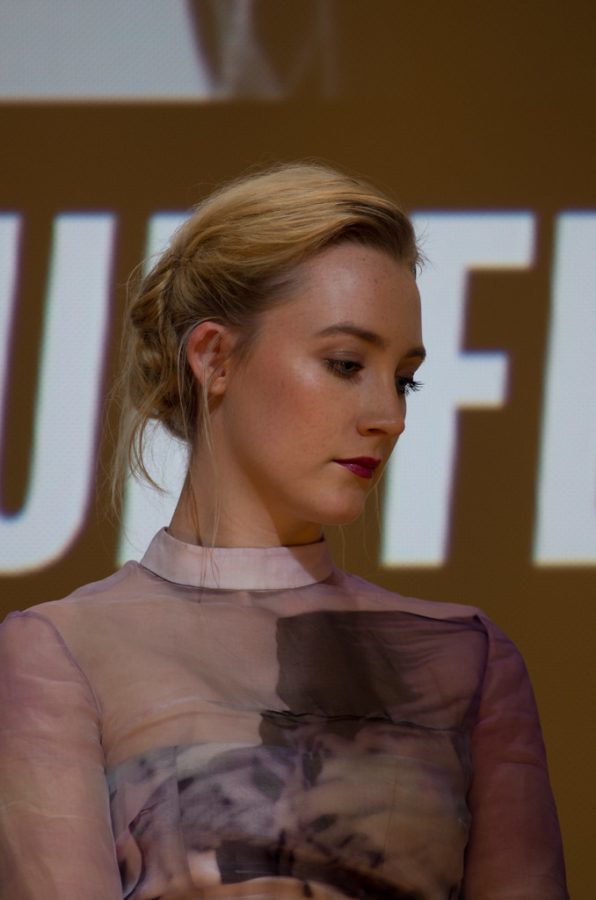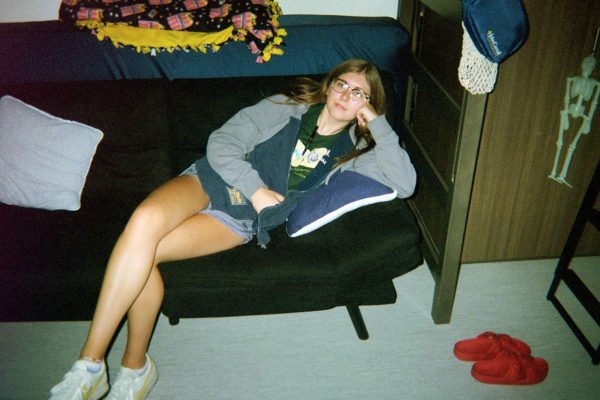Saoirse Ronan and the power of a closeup
Campus Editor Grace Sherban writes about her love for Saoirse Ronan’s powerful acting.
Feb 2, 2023
In “Sunset Boulevard,” the aging, disillusioned silent film star Norma Desmond states, “We didn’t need dialogue. We had faces!” There are a lot of actors working in the business today that, in Desmond’s words, act with their face. Yet one actress subtly leads the modern pack.
Saoirse Ronan is well known within popular culture, whether it be for her performances in “Lady Bird” and “Little Women” or her hard to pronounce Irish name. Ronan has become a staple within the modern film industry as one of the most consistent – albeit underappreciated – stars of our generation. Her stature in the industries is due, in part, to her ability to act solely with facial expressions.
An astute viewer will pick up on the fact that most films where Ronan stars as the lead ends with her face in a medium or close up shot of her in the final moments of a film. There are exceptions to this rule, specifically “Brooklyn,” but she is always in the final shot in some capacity.
To gather a deeper appreciation for Ronan’s work, we are going to take a look at the final moments of her two most famous films, “Lady Bird” and “Little Women,” and try to unravel how these endings impact the overall interpretation of these films.
1.) “Little Women” directed by Greta Gerwig
“And I’m so sick of people saying that love is all a woman is fit for. I’m so sick of it… but I’m so lonely”
“Little Women” is based on the Louisa May Alcott novel of the same name and follows the trials and tribulations of four sisters growing up in Civil War-era Massachusetts. The story documents the lives of these four sisters as they navigate love and loss with the main character being Jo March, played by Ronan. Jo is a headstrong writer who doesn’t fit in with the Victorian etiquette of her time.
The final moments show Jo receiving her freshly bound novel, which the audience can interpret as the novelized version of the events that just took place on screen. This is the scene where Ronan, for lack of a better term, pops off.
Jo is handed her novel and the audience sees the only childhood flashback of the entire film. We jump to Jo who turns around and watches as her story continues to come off the printing press. She hugs her copy to her stomach as if she is hugging her sisters.
On her face, we can see her reminisce about those moments with her sisters and how she greatly misses everything that childhood granted her. She looks down for a beat before raising her head and a look of determination – with a hint of sadness – rests on her visage. Her mouth forms an almost imperceivable frown before she takes a breath, rolls back her shoulders and then that frown becomes a slight smile. Cut to black, roll the credits.
In terms of acting, there are a myriad of interpretations and emotions being portrayed in the final 27 seconds of the entire movie. In fact, the whole movie can be summed up in the minute facial movements of Ronan. The choice to end on Jo accomplishing her biggest aspiration, to write a novel, with her family at the heart of it all makes the closeup so much more impactful. All of this subtext is provided by Ronan.
2.) “Lady Bird” directed by (yet again) Greta Gerwig
“Don’t you think maybe they are the same thing? Love and attention?
Gerwig’s directorial debut “Lady Bird” follows the self-named Lady Bird during her senior year at her Catholic high school. The movie deals with romantic, platonic and family relationships, but it’s specifically centered on the mother-daughter dynamic.
The film ends with Lady Bird leaving her home town of Sacramento to attend college in New York City. Her relationship with her mom is almost nonexistent as they haven’t spoken for quite some time. In New York, Lady Bird ends up in the hospital after a night of college partying. She leaves the hospital and goes to Sunday morning mass. After the service, she goes outside and immediately calls her parents but is sent to voicemail.
In the voicemail directed to her mother, she says “Hey mom, did you feel emotional the first time that you drove in Sacramento? I did and wanted to tell you but we weren’t really talking when it happened. All those bends I’ve known my whole life, and stores, and the whole thing. But I wanted to tell you I love you. Thank you, I’m…thank you.”
As Lady Bird speaks, we see a montage of her driving through Sacramento and the different landmarks that she passes. A shot of her then cuts to a shot of her mother driving in the same place from the same camera angle.
After the message is over, Lady Bird looks at her hands as she closes her flip phone. Her face shows a look of bewilderment as if she is realizing that moving to New York was a mistake. No matter where she goes, those family relationships and issues are still going to be at the root of a lot of her current problems.
She then looks up with confusion on her face. She turns to her right and exhales as if she’s internally asking herself, “what am I doing here?” Cut to black, roll the credits.
If there aren’t tears in your eyes after watching this final scene, are you human? Ronan once again brings it home with her performance and is able to visualize that confused, young adult feeling that is so hard to put into words.
Lady Bird feels regret but, at the same time, is optimistic about what the rest of her life will have to offer because of what she lived through with her family and friends. It may be hard to admit, but a person’s past does define who they are, and the ending solidifies that Lady Bird is able to come to terms with this truth. Despite her previous actions, Lady Bird embraces the idea of her home and family being at the core of who she is.
After analyzing the emotional impact of the finales of both films, it is clear that the weight of these scenes is indebted to Ronan’s performances. With four Academy Award nominations before the age of 30, she has undoubtedly cemented herself as a powerhouse within the industry. Hopefully, she will bring down the house yet again in the final scene of her next project and finally win that elusive Oscar for Best Actress.













